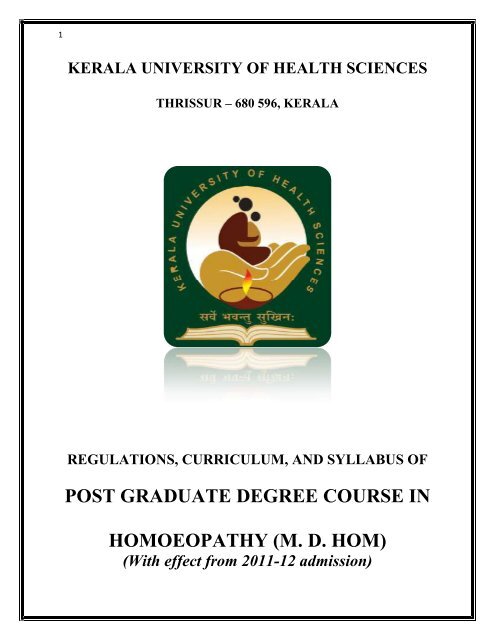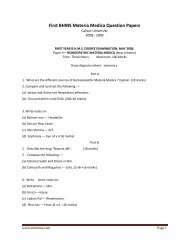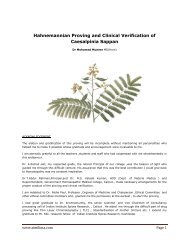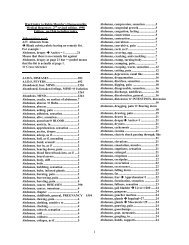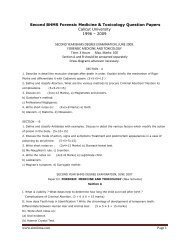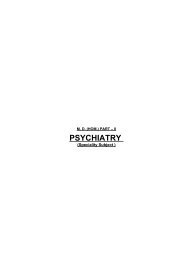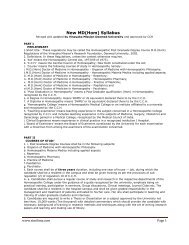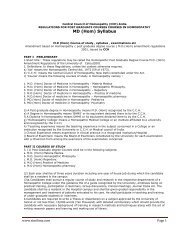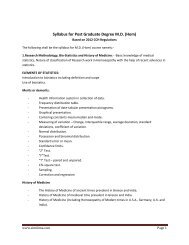KUHS – Kerala University of Health Sciences – MD (Hom - Similima
KUHS – Kerala University of Health Sciences – MD (Hom - Similima
KUHS – Kerala University of Health Sciences – MD (Hom - Similima
You also want an ePaper? Increase the reach of your titles
YUMPU automatically turns print PDFs into web optimized ePapers that Google loves.
1<br />
KERALA UNIVERSITY OF HEALTH SCIENCES<br />
THRISSUR <strong>–</strong> 680 596, KERALA<br />
REGULATIONS, CURRICULUM, AND SYLLABUS OF<br />
POST GRADUATE DEGREE COURSE IN<br />
HOMOEOPATHY (M. D. HOM)<br />
(With effect from 2011-12 admission)
2<br />
1. Introduction<br />
1.1 Preamble<br />
1.2 Nomenclature <strong>of</strong> Degree<br />
2. Aims and Objectives <strong>of</strong> Courses<br />
CONTENTS<br />
1.1 Goal<br />
1.2 General Objectives <strong>of</strong> Post Graduate Training<br />
1.3 Components <strong>of</strong> Post Graduate Curriculum<br />
3. Regulations<br />
3.1 Academic Eligibility for Admission<br />
3.2 Selection <strong>of</strong> Students<br />
3.3 Registration<br />
3.4 Duration <strong>of</strong> course<br />
3.5 Medium <strong>of</strong> Instruction<br />
3.6 Attendance<br />
3.7 Post Graduate Department<br />
3.8 Qualification <strong>of</strong> Teacher/Examiner/Guide<br />
3.9 Student Teacher Ratio<br />
3.10 Training Programme<br />
3.11 Log Book<br />
3.12 Teaching<br />
3.13 Research<br />
3.14 Thesis<br />
3.15 Obtaining eligibility certificates<br />
3.16 Examinations<br />
3.17 Criteria for Pass<br />
3.18 Award <strong>of</strong> Degree<br />
3.19 Migration and Transfer<br />
3.20 Norms <strong>of</strong> re-admission<br />
4. Course Content<br />
4.1 Syllabus and Scheme <strong>of</strong> Examination
3<br />
1. INTRODUCTION<br />
1.1 PREAMBLE<br />
The regulation <strong>of</strong> the Post Graduate courses in <strong>Hom</strong>oeopathy being conducted by the<br />
<strong>Kerala</strong> <strong>University</strong> <strong>of</strong> <strong>Health</strong> <strong>Sciences</strong> is in accordance with the recommendations <strong>of</strong> the Central<br />
Council <strong>of</strong> <strong>Hom</strong>oeopathy with an emphasis on the health needs <strong>of</strong> the <strong>Kerala</strong> State.<br />
1.2 NOMENCLATURE OF THE DEGREE<br />
1.2.1.<strong>MD</strong>(HOM)- Doctor <strong>of</strong> Medicine in <strong>Hom</strong>oeopathy- Materia Medica<br />
1.2.2. <strong>MD</strong>(HOM) - Doctor <strong>of</strong> Medicine in <strong>Hom</strong>oeopathy- <strong>Hom</strong>oeopathic Philosophy<br />
1.2.3. <strong>MD</strong>(HOM)-Doctor <strong>of</strong> Medicine in <strong>Hom</strong>oeopathy- Repertory<br />
2. AIMS AND OBJECTIVES OF COURSES<br />
2.1. GOAL<br />
The goal <strong>of</strong> Post Graduate <strong>Hom</strong>oeopathic Medical education shall be to produce competent<br />
specialists and /or Teachers.<br />
2.1.1. Who shall recognize the health needs <strong>of</strong> the community, and carry out pr<strong>of</strong>essional<br />
obligations ethically and in keeping with the objectives <strong>of</strong> the National health policy.<br />
2.1.2. Who shall have mastered most <strong>of</strong> the competencies, pertaining to the speciality, that are<br />
required to be practiced at the secondary and the tertiary levels <strong>of</strong> the health care delivery<br />
system.<br />
2.1.3. Who shall be aware <strong>of</strong> the contemporary advance and developments in the discipline<br />
concerned.<br />
2.1.4. Who shall have acquired a spirit <strong>of</strong> scientific inquiry and is oriented to the principles <strong>of</strong><br />
research methodology and epidemiology.<br />
2.1.5. Who shall have acquired the basic skills in teaching <strong>of</strong> the medical and paramedical<br />
pr<strong>of</strong>essionals.<br />
2.2 GENERAL OBJECTIVES OF POST GRADUATE TRAINING<br />
to;<br />
At the end <strong>of</strong> the Post Graduate training in the discipline concerned the student shall be able<br />
2.2.1 Recognize the importance to the concerned speciality in the context <strong>of</strong> the health needs <strong>of</strong><br />
the community and the national priorities in the health sector.
4<br />
2.2.2 Practice the speciality concerned ethically and in step with the principles <strong>of</strong> primary<br />
health care.<br />
2.2.3 Demonstrate sufficient understanding <strong>of</strong> the basic sciences relevant to the concerned<br />
speciality.<br />
2.2.4 Identify social, economic, environmental, biological and emotional determinants <strong>of</strong> health<br />
in a given case, and take them into account while planning therapeutic, rehabilitative,<br />
preventive and primitive measure/strategies.<br />
2.2.5 Diagnose and manage majority <strong>of</strong> the conditions in the speciality concerned on the basis<br />
<strong>of</strong> clinical assessment, and appropriately selected and conducted investigations.<br />
2.2.6 Plan and advise measures for the prevention and rehabilitation <strong>of</strong> patients suffering from<br />
disease and disability related to the speciality.<br />
2.2.7 Demonstrate skills in documentation <strong>of</strong> individual case details as well as morbidity and<br />
mortality rate relevant to the assigned situation.<br />
2.2.8 Demonstrate empathy and humane approach towards patients and their families and<br />
exhibit interpersonal behaviour in accordance with the societal norms and expectations.<br />
2.2.9 Play the assigned role in the implementation <strong>of</strong> National health programme, effectively<br />
and responsibly.<br />
2.2.10 Organize and supervise the chosen/assigned health care services demonstrating adequate<br />
managerial skills in the clinic/hospital or the field situation.<br />
2.2.11 Develop skills as a self-directed learner, recognize continuing education needs; select and<br />
use appropriate learning resources.<br />
2.2.12 Demonstrate competence in basic concepts <strong>of</strong> research methodology and epidemiology,<br />
and be able to critically analyze relevant published research literature.<br />
2.2.13 Develop skills in using educational methods and techniques as applicable to the teaching<br />
<strong>of</strong> medical/nursing students, general physicians and paramedical health workers.<br />
2.2.14 Function as an effective leader <strong>of</strong> a health team engaged in health care, research and<br />
training.<br />
2.3 COMPONENTS OF THE POSTGRADUATE CURRICULUM<br />
The major components <strong>of</strong> the Postgraduate curriculum shall be:-<br />
2.3.1 Theoretical knowledge<br />
2.3.2 Practical and clinical skills<br />
2.3.3 Writing thesis/Research articles<br />
2.3.4 Publishing scientific articles in accredited journals.<br />
2.3.5 Improving attitudes including communication skills.<br />
2.3.6 Training in research methodology, medical ethics including medico legal aspects.<br />
The students undergoing Post Graduate courses shall be exposed to the following:-<br />
i. Basics <strong>of</strong> statistics to understand and critically evaluate published research paper.<br />
ii. Lectures related to human behaviour studies.<br />
iii. Introduction to the non-linear mathematics.
5<br />
3. REGULATIONS<br />
3.1 ACADEMIC ELIGIBILITY FOR ADMISSION<br />
No candidate shall be admitted to <strong>MD</strong> (HOM) course unless he posses the degree <strong>of</strong>:<br />
a) Bachelor <strong>of</strong> <strong>Hom</strong>oeopathic Medicine and Surgery or equivalent qualification in<br />
<strong>Hom</strong>oeopathy after undergoing a course <strong>of</strong> study <strong>of</strong> not less than five and half years<br />
duration including one year compulsory internship: or<br />
b) Bachelor <strong>of</strong> <strong>Hom</strong>oeopathic Medicine and Surgery(GadedDegree)or equivalent qulification<br />
in <strong>Hom</strong>oeopathy included in the Second shedule <strong>of</strong> the Act, after undergoing a course <strong>of</strong><br />
study not less than two years doration.<br />
3.2 SELECTION OF STUDENTS<br />
The selection <strong>of</strong> students for the Post Graduate course shall be made based strictly on merit as<br />
decided by the Entrance Examination conducted by the competent authority approved by the<br />
Government <strong>of</strong> <strong>Kerala</strong>/<strong>Kerala</strong> <strong>University</strong> <strong>of</strong> <strong>Health</strong> <strong>Sciences</strong> and as per guidelines <strong>of</strong> the<br />
respective Council.<br />
3.3 REGISTRATION<br />
A candidate on admission to the <strong>MD</strong> (HOM) shall apply to the <strong>University</strong> for regstration<br />
3.3.1. By making a formal application in the prescribed format<br />
3.3.2. Original degree certificate/ mark list<br />
3.3.3. Original Council registration crtificate.<br />
3.3.4. Equivalency and migration certificate wherever needed.<br />
3.3.5 Original SSLC/ equivaleny certificate.<br />
3.3.6. The fees prescribed for the course.<br />
3.4 DURATION OF COURSE<br />
Every candidate seeking admission to the training programme to qualify for the Degree<br />
<strong>of</strong> <strong>MD</strong> (<strong>Hom</strong>) in the subjects conducted under the <strong>University</strong> shall pursue a regular course <strong>of</strong><br />
study, in the concerned Department under the guidance <strong>of</strong> a recognized Post Graduate teacher for<br />
a period <strong>of</strong> three years.<br />
The course shall be<strong>of</strong> three years duration, including one year <strong>of</strong> house-job or equivalent there<strong>of</strong><br />
3.4.1. Course shall comprise:
6<br />
1) General subject<br />
a) Man in <strong>Health</strong>( Holistic concept)<br />
b) Man in Disease( Holistic concept)<br />
c) History <strong>of</strong> Medicine, Scientific methedology including reasearch methodologyand Statitics<br />
2) Special subject<br />
<strong>Hom</strong>oeopathic Materia Medica/<strong>Hom</strong>oeopathic Philosophhy/Repertory<br />
A candidate for <strong>MD</strong>(<strong>Hom</strong>) shall opt one <strong>of</strong> the special subject as his speciality at the time <strong>of</strong><br />
admission and the degree shall be awarded in that speciality.<br />
3.4.2. Period <strong>of</strong> completion <strong>of</strong> course - Twice the duration <strong>of</strong> the course<br />
3.5 MEDIUM OF INSTRUCTION<br />
The medium <strong>of</strong> instruction is English.<br />
3.6 ATTENDANCE<br />
All the candidates joining the Post Graduate training programme shall work as full time<br />
residents during the period <strong>of</strong> training and shall attend not less than 80 percent <strong>of</strong> the imparted<br />
training during each calendar year including assignments, full time responsibilities and<br />
participation in all facets <strong>of</strong> the educational process. The student will be permitted to avail casual<br />
leave for 20 days, but not more than 10 days at a stretch. 365 days <strong>of</strong> the year are working days<br />
for post graduate students. Condonation <strong>of</strong> attendance will be allowed as per Rules.<br />
3.7 POST GRADUATE DEPARTMENT<br />
3.7.1. The centre shall fulfill the minimum requirements as prescribed in the <strong>Hom</strong>oeopathy<br />
(Minimum standard <strong>of</strong> Education) Regulation 1983 for undergraduate training. The<br />
centre shall obtain evaluation and approval from the Central Council <strong>of</strong> <strong>Hom</strong>oeopathy<br />
before starting <strong>of</strong> <strong>MD</strong> Course<br />
3.7.2. Post Graduate Department should have the following additional facilities namely,<br />
a) One full time Pr<strong>of</strong>essor in the department <strong>of</strong> speciality<br />
b) One Reader/Associate Pr<strong>of</strong>essor<br />
c) Staff such as Attendants<br />
d) Departmental Library<br />
e) Outpatient and inpatient departments with all facilities including clinical lab.<br />
f) Three beds shall be earmarked for each student
7<br />
3.8 QUALIFICATION OF TEACHER/EXAMINER/GUIDE<br />
3.8.1. <strong>MD</strong> (HOM) degree (3 yrs <strong>of</strong> regular study) in the concerned subject, included in the<br />
second schedule <strong>of</strong> the act.<br />
3.8.2. Reader/ Associate Pr<strong>of</strong>essor with a total teaching experience <strong>of</strong> not less than seven years<br />
in the concerned subject<br />
3.8.3. Maximum age limit <strong>of</strong> Examiner shall be 70 years<br />
3.9 STUDENT TEACHER RATIO<br />
The ratio <strong>of</strong> the Post Graduate teacher to the number <strong>of</strong> students to be admitted shall be 1:3.<br />
3.10 TRAINING PROGRAMME<br />
3.10.1. Every institution undertaking Post Graduate training shall set up an Academic cell or a<br />
curriculum committee, under the chairmanship <strong>of</strong> a senior faculty, which shall work out<br />
the details <strong>of</strong> the training in each speciality in consultation with other department<br />
faculty staff and also coordinate and monitor the implementation <strong>of</strong> these training<br />
programme.<br />
3.10.2. The training programme shall be updated as and when required. The structured training<br />
programme shall be written up and strictly followed, to enable the examiners to<br />
determine the training undergone by the candidate and the Central council inspectors to<br />
assess the same at the time <strong>of</strong> inspection.<br />
3.10.3. The Post Graduate student shall maintain a record(log book) <strong>of</strong> the work carried out by<br />
them and the training programme undergone during the period <strong>of</strong> training.<br />
3.10.4. The record book shall be checked and assessed by the faculty members imparting the<br />
training, monthly.<br />
3.10.5. The Post Graduate student shall be required to participate in teaching and training<br />
programme <strong>of</strong> undergraduate students and interns.<br />
3.11 LOGBOOK<br />
Log book serve as a document <strong>of</strong> the trainee’s work. The trainee shall maintain this Logbook<br />
<strong>of</strong> Journal review presentation/Seminar presentation/Clinical works in IPD and OPD/Clinical<br />
presentation/Teaching skill practice and Dissertation presentation.<br />
3.12 TEACHING<br />
All Post Graduate Student should take part in the teaching <strong>of</strong> undergraduate medical students.
8<br />
3. 13 RESEARCH<br />
M. D. (<strong>Hom</strong>) students shall present at least one paper/poster presentation at a State/National<br />
conference during their course. Each P.G. student shall present10 seminar papers, take part in at<br />
least 20 seminars/ symposium during the P.G. course and maintain the records <strong>of</strong> seminar<br />
notes/presentations and also he/she should present a paper /participate in at least one national<br />
level seminar/conferences.<br />
3.14 THESIS<br />
Every candidate shall carry out work on an assigned research project under the guidance <strong>of</strong> a<br />
recognized Post graduate teacher as a guide. All Post graduate students should submit a synopsis<br />
<strong>of</strong> the thesis duly attested by the competent authorities in the prescribed pr<strong>of</strong>orma within six<br />
months after the date <strong>of</strong> admission. Candidate is required to write a theses or dissertation on a<br />
subject approved by the <strong>University</strong> <strong>of</strong> not less than 10,000 (Ten Thousand) words.<br />
Each candidate should submit the dissertation six months prior to the completion <strong>of</strong> the course.<br />
The <strong>University</strong> will sent it to three experts (one internal two external) with instructions to return<br />
it within two weeks after valuation.<br />
Dissertation may classified as “Accepted”, “Accepted with modifications” or “Rejected”. At<br />
least two experts should accept the dissertation for it to be considered as accepted.If it is<br />
accepted with modifications, the candidate will be given 45 days for correction and resubmission<br />
through proper channel. If it is rejected, the candidate will not be permitted to appear for the<br />
examination. She/ he should repeat the work and submit within a period <strong>of</strong> six months. Such<br />
dissertations will be valued in the examination Centre itself at the time <strong>of</strong> practical / clinical<br />
examination<br />
3.15OBTAINING ELIGIBILITY CERTIFICATES<br />
The <strong>University</strong> will release the Provisional & Permanent degree certificate only on the<br />
receipt <strong>of</strong> the course certificate issued by the Principal, based on the recommendation <strong>of</strong> the<br />
Head <strong>of</strong> the concerned department <strong>of</strong> the course. The course commences from the date on which<br />
the first candidate joins the course.<br />
3.16EXAMINATION<br />
The examination shall be conducted in two parts namely:<br />
(a) M.D.(<strong>Hom</strong>) Part I, which is to be held six months after completion <strong>of</strong> house job <strong>of</strong> one year’s<br />
duration.<br />
(b) M.D.(<strong>Hom</strong>) Part II, which is to be held one year six months after Part I examination.
9<br />
Part I Examination<br />
Every candidate seeking admission to Part I <strong>of</strong> the examination shall submit application to the<br />
<strong>University</strong> with the following documents, namely:<br />
(a) A certificate from the Principal or Head <strong>of</strong> the institution about the completion <strong>of</strong> the course<br />
<strong>of</strong> studies in the subjects in which the candidate seeks admission to the examination; and<br />
(b) A certificate <strong>of</strong> having completed one year house job in the collegiate hospital.<br />
Viva and practical examination <strong>of</strong> Part-1 Exam will be conducted by the panel <strong>of</strong> examiners as<br />
below.<br />
- Man in health - teachers <strong>of</strong> Materia medica<br />
- Man in disease - teachers <strong>of</strong> Repertory<br />
- History <strong>of</strong> medicine & Statistics - teachers <strong>of</strong> <strong>Hom</strong>oeopathic philosophy<br />
Case taking and bedside evaluation will be the part <strong>of</strong> Man in disease with a view to<br />
providing experience to prospective Internal examiner, Skilled Assistants may be permitted, in<br />
concurrence with the External Examiners, to bepresent in the Examination Hall. The role <strong>of</strong><br />
skilled assistants, however, shall be confidential, only to carrying out the instructions.<br />
Examiners<br />
1. <strong>MD</strong> (<strong>Hom</strong>) Regular degree in concerned subject,(3years <strong>of</strong> regular study), included in the<br />
second schedule <strong>of</strong> the act.<br />
2. Reader/ Associate Pr<strong>of</strong>essor with a total teaching experience <strong>of</strong> not less than seven years<br />
in the concerned subject<br />
3. A panel <strong>of</strong> examiners shall be prepared by the <strong>University</strong> for a period <strong>of</strong> 3 years which<br />
shall be approved by the Central Council <strong>of</strong> <strong>Hom</strong>oeopathy<br />
One <strong>of</strong> examiners shall be the guide. Minimum number <strong>of</strong> examiners shall be three ,out <strong>of</strong> which<br />
50% should be external.<br />
3.17 CRITERIA FOR PASS<br />
A candidate who has secured minimum <strong>of</strong> 50 percent marks for theory (40 percent separate<br />
minimum for each paper), 50 percent for Clinical/Practical including oral shall be declared to<br />
have passed in that subject.<br />
A candidate who fails in one subject have to appear only for the failed subjects in<br />
M D(HOM)PartI&PartII.<br />
3.18 AWARD OF DEGREE<br />
A Candidate who has passed all the subject <strong>of</strong> <strong>MD</strong> (HOM) will be eligible for award <strong>of</strong><br />
degree.
10<br />
3.19 MIGRATION AND TRANSFER<br />
Migration / Transfer <strong>of</strong> students undergoing any post graduate course shall not be<br />
permitted under any circumstances<br />
3.20 NORMS OF RE-ADMISSION<br />
If a candidate is not appearing in the college for more than six months, he/she, on the<br />
recommendation <strong>of</strong> the head <strong>of</strong> Institution should get permission from the university for rejoining.<br />
Re- admission will be considered strictly as per the conditions stipulated in the norms <strong>of</strong> the<br />
respective Statutory Council/<strong>Kerala</strong> <strong>University</strong> <strong>of</strong> <strong>Health</strong> <strong>Sciences</strong>.<br />
4. COURSE CONTENT<br />
4.1 SYLLABUS AND SCHEME OF EXAMINATION OF EXISTING <strong>MD</strong> (HOM)<br />
COURSE<br />
PART I<br />
Course <strong>of</strong> study<br />
1.Post graduate degree course shall be in the following subjects<br />
a. <strong>MD</strong>(<strong>Hom</strong>) <strong>Hom</strong>eopathic Materia Medica<br />
b. <strong>MD</strong> (<strong>Hom</strong>) <strong>Hom</strong>eopathic Philosophy<br />
c. <strong>MD</strong> (<strong>Hom</strong>) Repertory<br />
2.The course shall be <strong>of</strong> three years duration, including one year <strong>of</strong> house-job or equivalent<br />
there<strong>of</strong><br />
a. All the days <strong>of</strong> the year will be working days for the post graduate students.<br />
b. The candidate should secure 80% attendance for the<br />
3. Course shall comprise:<br />
1. General subject<br />
i First year, i.e. during house job.<br />
ii First half <strong>of</strong> 2 nd year.(183days)<br />
iii Last one and half year.<br />
a. Man in <strong>Health</strong> (Holistic concept)<br />
b. Man in diseases (Holistic concept)
11<br />
2. Special subject<br />
<strong>Hom</strong>eopathic Materia Medica / <strong>Hom</strong>eopathic Philosophy / Repertory<br />
A candidate for <strong>MD</strong> (<strong>Hom</strong>) shall opt one <strong>of</strong> the special subject as his speciality at the time<strong>of</strong><br />
admission and the degree shall be awarded in that speciality.<br />
4. The PG candidate shall pursue a regular course <strong>of</strong> study and research in the department under<br />
the guidance <strong>of</strong> a guide recognized by the university, emphasis being on practical training,<br />
participate in seminars, group discussions, clinical meetings, journal clubs etc.<br />
5.The candidate shall be a resident in the hospital campus and shall be given graded<br />
responsibility in the management <strong>of</strong> patients entrusted to his care. He shall participate in teaching<br />
and training <strong>of</strong> undergraduate student and internees.<br />
6. Candidate is required to write a theses or dissertation on a subject approved by the <strong>University</strong><br />
<strong>of</strong> not less than 10,000 (Ten Thousand) words.<br />
7.The PG student may be permitted to attend seminars, symposium and other academic<br />
programmes conducted by registered organizations, academic bodies and institutions in and<br />
outside state. The head <strong>of</strong> institution shall sanction duty leave to PG students, limited to 20 days<br />
in an academic year.<br />
8.The student shall be required to attend at least 80% <strong>of</strong> total lecture, seminar, clinical<br />
discussion, journal club and group discussion separately in each paper/subject <strong>of</strong> the examination<br />
in order to become eligible to appear for examination.<br />
9.Method <strong>of</strong> training: The emphasis should be on in service training and not on didactic lectures.<br />
The candidates should take part in seminars, group discussions, clinical meetings etc. The<br />
candidate should be required to write a thesis or dissertation with detailed commentary which<br />
should provide the candidate with necessary background <strong>of</strong> training in research methods and<br />
techniques along with the art <strong>of</strong> writing research papers and learning and making use <strong>of</strong> library.<br />
The candidate shall be a resident in the campus and shall be given grader responsibility in the<br />
management and treatment <strong>of</strong> patients entrusted to his case. He shall participate in teaching <strong>of</strong><br />
undergraduate students or interns. Adequate number <strong>of</strong> posts <strong>of</strong> clinical residents shall be created<br />
for this purpose.<br />
PART II<br />
Syllabus<br />
1. Syllabus for Post Graduate Degree M.D. (<strong>Hom</strong>.):<br />
The following shall be syllabus for general and special subjects in M.D. (<strong>Hom</strong>.) course<br />
namely:-
12<br />
A.GENERAL SUBJECTS (Common to all specialities)<br />
(I) The Man In <strong>Health</strong> (Holistic Concept)<br />
Structural functional and psychological organization <strong>of</strong> Man and his adaptation to the<br />
environment in health, and includes an integrated study <strong>of</strong> the following for practical<br />
application <strong>of</strong> this knowledge in clinical medicine.<br />
Concept <strong>of</strong> <strong>Health</strong>-Different approaches-Holistic concept-Definitions Dimensions<br />
&Determinants <strong>of</strong> health<br />
General Anatomy<br />
1. Development Anatomy<br />
2.(a)Genetics and individuality (b)Elementary principles <strong>of</strong> genetics (c) Applied Genetics<br />
3.Interaction between organism and environment.<br />
1.Neuro Anatomy<br />
(a) Meninges and their function<br />
(b)Cerebellum-Areas, vascular supply and functions<br />
(c)Cerebellum-functions<br />
(d)Pons<br />
(e)Midbrain<br />
(f)Cranial Nerves<br />
(g)CSF<br />
(h)Spinal cord-segmental relations<br />
(i)Nerve distribution<br />
Applied-Lumbar puncture, Referred pain, and Spinal Anesthesia<br />
2.Thorax<br />
(a)Skeleton structure<br />
(b)Diaphragm<br />
(c)Pleura and Lungs<br />
(d)Heart and Major vessels<br />
(e)Mediastinum<br />
Applied: Surface making-Cardia, Lungs, Valves, Aorta and Superior Vena Cava<br />
3.Abdomen and Pelvis:<br />
(a)Abdominal muscles<br />
(b)Peritoneum<br />
(c)Blood Vessels<br />
(d)Stomach and intestine<br />
(e)Liver and Gall Bladder<br />
(f)Pancreas
13<br />
(g)Kidney and Urinary tract<br />
(h)Uterus and Ovary<br />
Applied: Surface markings <strong>of</strong> organs, referred pain<br />
4.Head and Neck:<br />
(a)Scalp and its Vascular Supply<br />
(b)Facial muscles<br />
(c)Muscles <strong>of</strong> Mastication<br />
(d)Innervations <strong>of</strong> skin<br />
(e)Eye<br />
(f)Nasal cavity<br />
(g)Oral cavity<br />
(h)Larynx<br />
(i)Thyroid and Parathyroid<br />
(j)Esophagus and Trachea<br />
Micro Anatomy<br />
Histology <strong>of</strong>-<br />
(a) Nerve (b)Muscles (c)Bone<br />
(d)Cardiac Muscles (e) Liver (f)Testis, Ovary<br />
(g)Uterus and Cervix (h)Spinal Cord (i)Lymph nodes<br />
(j) Thyroid (k)Lungs (l)Lymph nodes<br />
PHYSIOLOGY<br />
With the advent <strong>of</strong> latest physical principles physiology has made rapid progress in<br />
bringing out hitherto unknown aspects <strong>of</strong> functions <strong>of</strong> human body. A renewed interest is<br />
therefore ie essential for all postgraduate in the medical field. Keeping this interest in<br />
sight the students may study the applied/clinical aspect <strong>of</strong> the following and any other<br />
important topic.<br />
1) Haematology<br />
(a)Formed Elements<br />
(b)Plasma<br />
(c)Erythropoesis<br />
(d)Leucopoiesis<br />
(e)Thrombopoeisis<br />
(f) Coagulations<br />
(g)Blood Groups<br />
(h)Leukemia<br />
(i)Haemoglobinopathies<br />
(j)Immunological vascular flow
14<br />
2) Cardio Vascular System<br />
(a)Structure <strong>of</strong> Heart and Cardiac muscles<br />
(b)Electro physiology and ECG<br />
(c)Cardiac cycle<br />
(d)Cardiac output<br />
(e)Blood Pressure<br />
(f)Echocardiography<br />
(g)Sonography<br />
(h)Peripheral vascular flow<br />
3) Respiratory System:<br />
(a)Structure <strong>of</strong> respiratory system (b) Mechanism <strong>of</strong> Respiration<br />
(c)Lung volume capacity (d)Enzymatic activity <strong>of</strong> Gastrointestinal tract and Liver<br />
4) Digestive System:<br />
(a)Esophagus and stomach (b) Intestine and Peristaltic activity<br />
(c)Hepatobiliary system (d) Enzymatic activity <strong>of</strong> Gastrointestinal tract and Liver.<br />
5) Urogenital system:<br />
(a)Structure <strong>of</strong> Kidney and Blood supply<br />
(b)Formation <strong>of</strong> Urine<br />
(c)<strong>Hom</strong>eostasis and blood pressure<br />
(d) Urinary tract (Ureter, bladder, urethra)<br />
(e)Primary sex organs-male and female<br />
(f)Prostate<br />
(g)Menstrual cycle<br />
(h)Spermatogenesis<br />
(i)Pregnancy, parturition, Lactation<br />
(j)Contraception, menopause<br />
(k)Libido<br />
6) Skin and Integument System:<br />
(a)Skin- Microscopy<br />
(b) Sweating Mechanism and other functions<br />
(c)Pigments<br />
7) Nervous System:<br />
(a) Neuro anatomy (h) Brain and Cranial nerves<br />
(b) Nerve conduction (i) Spinal cord functions
15<br />
(c)Functions <strong>of</strong> Cerebrum (j) Vestibular apparatus<br />
(d)Functions <strong>of</strong> cerebellum (k) Autonomous nervous system<br />
(e)Midbrain and Pons (l) Neurotransmitters-serotonin, endorphins etc<br />
(f)Basal Ganglion (m)Special sense,Taste,smell, vision, hearing, touch<br />
(g) Limbic system<br />
8) Endocrine system:<br />
BIO CHEMISTRY<br />
(a) General principles (e)Pancreas<br />
(b)Hypothalamus (f)Suprarenal glands<br />
(c)Pituitary gland (g)Gonads<br />
(d) Thyroid and Parathyroid<br />
Biochemistry has made great advances in recent years. A postgraduate medical student is<br />
required to keep update with the important development relevant to therapeutics. Hence a<br />
comprehensive review <strong>of</strong> clinical aspect is to be kept in mind to cover the following topics:<br />
1. Elementary constituents <strong>of</strong> cytoplasm<br />
2. Carbohydrates: (a) Monosaccharides (b)Disaccharides (c)Polysaccharides<br />
(d)Mucopolysaccharides (e) Carbohydrate digestion, absorption and metabolism (f) Citric Acid<br />
cycle<br />
3.Proteins: (a)Amino acids (b)Structural proteins (c) Plasma Proteins (d)DNA,RNA (e) Protein<br />
digestion, absorption and metabolism (f) End products (g)Urea Creatinne<br />
4. Lipids: (a)Saturated and unsaturated fatty acids (b)Triglycerides (c) Lipoproteins (d)Esters (e)<br />
Fat digestion (f) Absorption and metabolism (g) Keton bodies (h) Hormone synthesis<br />
5. Water and Electrolytes: (a) Water and electrolyte distribution (b) Starling’s principle (c)<br />
Functions <strong>of</strong> electrolytes (d) Acid base equilibrium.<br />
6. Nutrition and B.M.R: (a)Basic principles (b)Diet (c)BMR in health and disease (d) Obesity<br />
(a)Hormones, Enzyme activities (b) Neurotransmitters<br />
E) PSYCHOLOGY<br />
1. Introduction:<br />
(a)Definition<br />
(b) Nature<br />
(c) Subject matter<br />
(d) Brain and behavior<br />
2. Methods <strong>of</strong> psychology<br />
a) Experimental
16<br />
b) Questionnaire (Inventory)<br />
3. Clinical<br />
4. Survey<br />
5. Observation<br />
6. Developmental Theories<br />
a) Psycho-analytical/neoFreudians<br />
b) Psycho social<br />
c) Behavioral<br />
d) Humanistic<br />
7. Motivation:<br />
a) Classification-theories, <strong>Hom</strong>eostasis.<br />
b) Cognitive approach, Frustration, Conflicts, Mental mechanisms<br />
c) Stress: Meaning, definition, types & its effect on body<br />
d) Mind-body relationship<br />
e) Sources <strong>of</strong> stress/ Coping with stress<br />
f) Stress management (Relaxation, bi<strong>of</strong>eedback)<br />
8. Psychological Process:<br />
a) Sensation, Perception, Attention-Study <strong>of</strong> disorders in each <strong>of</strong> them<br />
9. Emotions<br />
a) Characteristics, expression (vocal, nonverbal)<br />
b) Internal physical changes<br />
c) Emotions & <strong>Health</strong><br />
10. Personality:<br />
a) Definition, Characteristics, Traits. Factors influencing Personality<br />
b) Assessment<br />
11. Intelligence<br />
a) Definition, Nature, Growth determinants, assessment, application.<br />
12) Learning<br />
a) Types-classical conditioning, Operant Conditioning<br />
b) Cognitive learning-application in medicine<br />
13. Memory and forgetting<br />
a) Process, types, Causes <strong>of</strong> forgetting<br />
b) Methods to improve memory<br />
14. Different approaches <strong>of</strong> psychology-Freud, Jung, Adler, Cattel, Horney<br />
(II) The Man in Disease (Holistic Concept)<br />
Structural, Functional, and psychological organization <strong>of</strong> the sick and his/her deficient adaptation<br />
to his/her environment and includes the study <strong>of</strong> pathology (psychological, functional and<br />
structural deviations from the state <strong>of</strong> <strong>Health</strong>). A probe into the evolutionary phenomenon <strong>of</strong><br />
disease, paying attention to the cause effect relationship (viz. the effects <strong>of</strong> extrinsic<br />
(microorganisms, parasites, viruses and other stimuli) and intrinsic (susceptibility based on<br />
miasmas) factors along with their current interpretations and abnormal expressions <strong>of</strong> the sick<br />
pervading his/her whole being).<br />
Concept <strong>of</strong> disease-Definitions-Holistic approach-Distinction between Disease, Illness &<br />
sickness
17<br />
Causation <strong>of</strong> disease-Environmental, biological, intrinsic factors etc.<br />
PATHOLOGY AND MICROBIOLOGY<br />
A thorough and comprehensive knowledge <strong>of</strong> disease processes is fundamental to any<br />
therapeutic approach with an aim <strong>of</strong> cure or palliation. Natural course <strong>of</strong> disease, prognosis are<br />
vital inputs for planning treatment strategies. The following topics need to be updated keeping<br />
<strong>Hom</strong>eopathic orientation <strong>of</strong> practice in view.<br />
PATHOLOGY<br />
1. General Pathology:<br />
(a) Inflammation and repair<br />
(b) Immunity and Hypersensitivity<br />
(c) Coagulation, thrombosis<br />
(d) Neoplasm<br />
(e) Pigmentation disorders<br />
(f) Ionizing radiation<br />
(g) Genetic factors in disease<br />
(h) Degeneration and cellular death<br />
2. Regional Pathology<br />
(a) Cardio vascular system <strong>–</strong> disease <strong>of</strong> heart, blood vessels, congestive heart failure<br />
(b) Disease <strong>of</strong> trachea: airway obstructions, parenchyma disease <strong>of</strong> lungs, disease <strong>of</strong> pleura,<br />
allergic disease and respiratory failure.<br />
(c) Disease <strong>of</strong> gastro intestinal tract: Oesophagitis, Peptic ulcer, malabsorption syndrome.<br />
(d) Disease <strong>of</strong> Hepatobiliary system: Hepatitis, Cirrhosis <strong>of</strong> liver, gall bladder disorders<br />
(e) Disease <strong>of</strong> kidney: Nephritis, Nephrotic syndrome and Urinary tract disorders<br />
(f) Disease <strong>of</strong> endocrines: Growth hormone disease, Pituitary disease, Thyroid, Parathyroid<br />
disease, diabetes mellitus, supra renal disease.<br />
3. Hematological diseases:<br />
(a) Anemia<br />
(b) Leukemia<br />
(c) Hemorrhagic diseases<br />
4. Neurological diseases:<br />
(a) Cerebro vascular diseases<br />
(b) Degenerative diseases <strong>of</strong> brain and spinal cord<br />
(c) Meningial disease<br />
(d) Cerebral palsies, congenital syndromes
18<br />
5. Disease <strong>of</strong> Bones and Joints:<br />
Rheumatoid arthritis, osteo-arthrosis, SLE and other connective disorders.<br />
6. Disease <strong>of</strong> skin:<br />
Dermatitis, pigment disorders, hyperkeratonic disorders and Veneral diseases.<br />
MICRO BIOLOGY:<br />
1. Infection and disease<br />
2. Microbial pathogenecity<br />
Bacterial<br />
Fungal<br />
Viral<br />
Parasitic<br />
3. Defenses <strong>of</strong> Host against infections<br />
Components <strong>of</strong> defense<br />
Functional setup <strong>of</strong> immunity<br />
Antigens<br />
Antibodies<br />
Cells <strong>of</strong> immune response<br />
Ag-Ab reaction<br />
Hypersensitivity<br />
Autoimmunity<br />
4. Diagnosis <strong>of</strong> microbial infections<br />
5. Preventive measures against microbial infections<br />
(III) History <strong>of</strong> Medicine, Scientific Methodology including Research Methodology and<br />
Statistics<br />
a) History <strong>of</strong> Medicine- evolution with special emphasis on Hahnemann’s contribution to<br />
medicine in General.<br />
b) Basic concept <strong>of</strong> Logic, Philosophy<br />
1. Introductory analysis Subject matter and scope- question for philosophy- The branches <strong>of</strong><br />
philosophy<br />
2. Philosophy and the sciences- Logic, metaphysics and theory <strong>of</strong> causation<br />
3. Logic-Inductive &deductive (On the basis <strong>of</strong> Aristotle, Lord Bacon, & J S Mill)<br />
4. The doctrine <strong>of</strong> Force- The Doctrine <strong>of</strong> monads- Life force (note- Should be dealt in the<br />
context <strong>of</strong> Leibniz & Bergson)<br />
5. Part and whole relation- Organic view- Philosophy <strong>of</strong> nature & Philosophy <strong>of</strong> mind (Note-<br />
Should be taught on the basis <strong>of</strong> Hegal)<br />
6. An outline treatment <strong>of</strong> the following recent trends: Existentialism, Realism &<br />
Phenomenology, Pragmatism, Positivism & Analytical Philosophy
19<br />
c) Scientific Methodology including research methodology & biostatics<br />
1. Definition and scope <strong>of</strong> Statistics<br />
2. Sources and Presentation <strong>of</strong> Statistical data, Primary data, Secondary data, Classification,<br />
Tabulation, Presentation <strong>of</strong> statistical data by diagrams, graphs, charts etc.<br />
3. Measures <strong>of</strong> Central tendency or averages<br />
Introduction- Difference averages-Definition- Merits &demerits- Partition values- Graphical<br />
location <strong>of</strong> the partition values<br />
4. Measures <strong>of</strong> variation or dispersion<br />
Introduction <strong>–</strong> definition <strong>of</strong> different measures <strong>of</strong> variation, Merits & demerits- Co- efficient <strong>of</strong><br />
variation- Skewness, Kurtosis<br />
5. Correlation & Regression scatter Diagram- Correlation coefficient- Limits <strong>of</strong> correlation<br />
coefficient-Rank correlation- Lines <strong>of</strong> Regression Coefficient<br />
6. Sampling Theory<br />
Introduction- Advantages <strong>of</strong> sampling- Principle steps in a sample survey- Different methods <strong>of</strong><br />
sampling- sampling and nonsampling error<br />
7.Theory <strong>of</strong> probability<br />
Introduction- Definition <strong>of</strong> various terms- Law <strong>of</strong> addition <strong>of</strong> Probability- Multiplication- Law <strong>of</strong><br />
Probability- Conditional Probability<br />
8. Theoretical Distributions<br />
Introduction-Binomial distribution- Normal Distribution, Chi-square Distribution & T<br />
Distribution- Standard error<br />
9. Tests <strong>of</strong> significance<br />
Introduction- Null hypothesis- Alternative Hypothesis- Level <strong>of</strong> significance <strong>of</strong> test- Type I<br />
error- Test <strong>of</strong> single proportion- Test <strong>of</strong> significances for different proportions-Test <strong>of</strong><br />
Significances for single means- Test <strong>of</strong> Significances for differences <strong>of</strong> means- Chi- square test-<br />
T test etc.<br />
10.Research Methodology<br />
Introduction-defining the research problem- research Design- Epidemiological studies- clinic<br />
trials- Writing <strong>of</strong> Research reports<br />
B. SPECIAL SUBJECTS<br />
(1) Organon <strong>of</strong> Medicine and <strong>Hom</strong>eopathic Philosophy:<br />
(i) Hahnemannian concepts <strong>of</strong> <strong>Hom</strong>eopathy (Principles and Practice)<br />
Resources and references should be clearly defined<br />
(a) Organon <strong>of</strong> medicine 5 th and 6 th Edition with appendix and introduction<br />
(b) Introduction- review <strong>of</strong> therapeutics<br />
(c) Fundamental principles <strong>of</strong> homeopathy<br />
(d) Evolution <strong>of</strong> the principles and practice <strong>of</strong> homeopathy by making a reference <strong>of</strong><br />
important topics <strong>of</strong> lesser writings <strong>of</strong> Hehnemann<br />
(e) A deep understanding <strong>of</strong> the subject is essential for making critical and analytical<br />
appreciation and evaluation <strong>of</strong> it<br />
(ii) <strong>Hom</strong>eopathic Philosophy
20<br />
a. Philosophy text books <strong>of</strong> Dr. Kent, Dr. H.A.Robert, Dr. Stuart Close, Dr.Dunham, Dr.<br />
Richard Hugehs has to be studied<br />
b. Miasm cocept <strong>of</strong> Hahnemann, Chronic disease and their peculiar nature, Chronic<br />
miasm by Dr.J.H. Allen,Miasm by Dr. Banerjee etc..<br />
c. Miasm concept <strong>of</strong> Dr. Kent, Dr. H. A. Robert, Dr. Stuart Close, Dr. Dunham, Dr.<br />
Richard Hugehs.<br />
d.Comparison <strong>of</strong> symptoms <strong>of</strong> miasm through referring text book S.K. Banerjee and<br />
Phyllis Speight<br />
e. Miasmatic evolution <strong>of</strong> symptoms <strong>of</strong> polychrest remedies based on the standard text<br />
book material medica<br />
(iii) Practice <strong>of</strong> <strong>Hom</strong>eopathy in Medicine, Surgery, Obstetrics and Gynaecology.<br />
The aetio pathological aspect, clinical features, management <strong>of</strong> clinically important most<br />
prevalent disease has to be studied. A student should be capable making an analysis and<br />
evaluation, miasmatic expression on the aetio pathological aspect and clinical features both at<br />
disease properly and at the individual level.<br />
PAPER DIVISION:<br />
Paper I- Items (i) above<br />
Paper II-Items (ii) above<br />
Paper III- Items (iii) above<br />
(II) <strong>Hom</strong>eopathic Materia Medica:<br />
I. Basic Materia Medica<br />
1. Materia Medica- Definition<br />
2. Sources:<br />
a. Of drugs- Plant, Animal etc<br />
b. Of symptoms- Drug proving, toxicological, clinical etc.<br />
c. Of Materia Medica, Source books<br />
3. Drug proving and collection <strong>of</strong> symptoms- Methodology <strong>of</strong> Hahnemann, CCRH, others<br />
4. Symptoms- Classification- different authors<br />
5. Materia Medica<br />
a. Scope and Limitations <strong>of</strong> Materia Medica<br />
b. Science and philosophy <strong>of</strong> Materia Medica<br />
c. Construction and Types <strong>of</strong> Meteria Medica<br />
d. Study <strong>of</strong> Materia Medica- different approaches<br />
e. Critical review <strong>of</strong> Materia Medica <strong>of</strong> various authors<br />
f. Application <strong>of</strong> Materia Medica- The elements involved <strong>Hom</strong>eopathic philosophy,<br />
Clinical medicine, <strong>Hom</strong>eopathic Repertory and Materia Medica pura
21<br />
II. Study <strong>of</strong> homeopathic drugs<br />
1. Study <strong>of</strong> pure effects <strong>of</strong> homeopathic drugs from all sources, books and to interpret the<br />
same<br />
. 2. Study <strong>of</strong> group characteristics with remedy differentiation<br />
3. Study <strong>of</strong> relationship <strong>of</strong> drugs<br />
4. Comparative study <strong>of</strong> Materia Medica<br />
a. Detailed study <strong>of</strong> polychrest drugs with their drug pictures<br />
b. Therapeutic indications <strong>of</strong> all drugs with special reference to rare remedies<br />
III. Practice <strong>of</strong> <strong>Hom</strong>eopathy in Medicine, Surgery, Obstetrics and Gynecology<br />
1. A systematic study <strong>of</strong> common diseases in internal medicine and its homeopathic<br />
management<br />
2. Iatrogenic diseases- its homeopathic management<br />
(III) Repertory:<br />
1. Chronological development <strong>of</strong> repertory from Dr. Hahnemann till now.Their<br />
developmental sources and reference to their methods origin and subsequent development or<br />
edition afterwards with special <strong>of</strong> study and way <strong>of</strong> approach. Study <strong>of</strong> evolution <strong>of</strong> repertory, so<br />
that a comprehensive knowledge can be achieved as (a) Introduction including source and origin<br />
<strong>of</strong> repertory, about writer developments and edition subsequently. (b) Philosophical backgrounds<br />
and fundamentals. (c) Doctrine. (d) Construction (e) Plan (f) Adaptability<br />
From Hahnemann→ Boenninghausen→ Kent→ Boger → Newer repertories →Synthetic→<br />
Synthesis →Complete → Murphy. The critical study <strong>of</strong> these repertories from different angles,<br />
their utility, advantages and disadvantages, scope and limitations<br />
2.Classification <strong>of</strong> repertories into different groups. Use and importance <strong>of</strong> different<br />
groups, Clinical application <strong>of</strong> different repertories in different types <strong>of</strong> cases.<br />
3. Terminology: Meaning <strong>of</strong> different technical terminology in studying repertory as<br />
rubric, subrubric, cross reference, similar rubric, gradation, rank, elimination generalization<br />
particularization and synthesis. Interpretation and analysis <strong>of</strong> terminology used in<br />
Boenninghausen’s, Kent’s, Murphy’s, Synthesis, Kneer’s, Boger’s repertories etc. and their<br />
applications in the light <strong>of</strong> modern knowledge.<br />
4. Symptomatology: Definition, Source, different varieties <strong>of</strong> symptoms, their interrelation<br />
and meaning with each other and value in analysis or anamnesis in a case as given by different<br />
authors till now. Concept <strong>of</strong> totality <strong>of</strong> symptoms and way <strong>of</strong> approach Hahnemann,<br />
Voenninghausen, Kent, Boger, Stuart Close, H.A. Robert and Richard Huges.Boger’s<br />
contribution to symptomatology and its importance.<br />
1. Understanding the study <strong>of</strong> symptomatology in detail along with the Miasmatic understanding.
22<br />
2. Applying this knowledge to analysis <strong>of</strong> the case from different perspectives<br />
3. Case analysis:<br />
Importance <strong>of</strong> anamnesis in case taking and Analysis methods and strategy by different authors<br />
4. Evaluation <strong>of</strong> symptoms:<br />
1. One needs to understand the concepts used in evaluation and its application. Why and how <strong>of</strong><br />
it.<br />
2. Understanding the different concepts used by different authors i.e. Kent, Boger, Boennighusen<br />
etc. for evaluation <strong>of</strong> symptom.<br />
3. Evaluation <strong>of</strong> symptom by Dr. Hahnemann, Boenninghausen, Kent, Boger, Stuart Close,<br />
H.R.Robert, Garth Boericks, Bidwell etc. Integrated, dynamic and evolutionary concept<br />
Hahnemannian totality.<br />
5. Case Taking: Art <strong>of</strong> Case Taking in different types <strong>of</strong> cases as in acute (Individual, Sporadic,<br />
Epidemic- Acute diseases with a Chronic background), Chronic (Mental diseases, intermittent<br />
with acute- exacerbation), analysis 0<strong>of</strong> the case, clinical diagnosis <strong>of</strong> the case and deduction <strong>of</strong><br />
the case for reportorial purpose. Repertorial approach in case taking. Utility <strong>of</strong> the repertory in<br />
presenting complaint, history <strong>of</strong> presenting complaint, past history, family history, treatment<br />
history, obstetrical history, age, sex etc.<br />
(a) Dynamics and Methods <strong>of</strong> case studying<br />
(b) Interview:<br />
1. Prerequisites<br />
a. Attitude<br />
b. Atmosphere<br />
c.Time<br />
d. Perspective<br />
2. Interview Structure<br />
3. Interview Process<br />
a. Initiation<br />
b. Body<br />
c. Conclusion<br />
4. Obstacle and anticipated difficulties<br />
5. Indiscretions to be avoided<br />
6. How to Do It <strong>–</strong> Techniques and Patterns <strong>of</strong> Interventions in different situations and category <strong>of</strong><br />
patients.<br />
7. Different methods <strong>of</strong> case taking in the class room, in clinic, open air, OPD, IPD, public and<br />
rural areas<br />
8. Difficulties in taking chronic cases
23<br />
9. Assessment<br />
10. To understand the Hering’s law <strong>of</strong> cure and its application in management <strong>of</strong> cases.<br />
6. Card repertory: History and development <strong>of</strong> different card repertories and classification.<br />
Plan construction, Philosophical background, working with method, clinical uses, advantages<br />
and disadvantages <strong>of</strong> Kishore’s cards.<br />
7. Study <strong>of</strong> different individual groups <strong>of</strong> repertories<br />
1. Logical utilitarian groups <strong>–</strong> Boenninghausan, Boger, Kent (along with Kunzliz, Pierri<br />
schmidt’s repertory)<br />
2. Puritan groups <strong>of</strong> repertories Gentry and Knerr<br />
3. Special or regional or particular group <strong>of</strong> repertory<br />
Bell’s diarrhea, Allen’s fever, Minton’s utrine disease, Berridge’s eye and Dougla’s skin.<br />
A systemic methodical study <strong>of</strong> each above groups <strong>of</strong> repertory and their adaptability and clinical<br />
area <strong>of</strong> uses.<br />
Historical Background: Detailed understanding <strong>of</strong> the historical evolutions <strong>of</strong> these repertories ,<br />
their Scope and Limitations. The different repertories and their evolutions along with concepts,<br />
philosophy and the necessity <strong>of</strong> these repertories. Understanding the different concepts used by<br />
different authors in construction and evalutions <strong>of</strong> these repertories.<br />
8. Detailed study <strong>of</strong> the following repertories:<br />
1. Boenninghausen 2.Kent 3. Boger 4.Synthetic 5.Murphy 6.Synthesis 7.Kneer 8.Complete<br />
repertory<br />
In- depth critical studies from different angles, their utility, advantages and disadvantages.<br />
Comparative study <strong>of</strong> philosophical background, chapter wise comparative study, comparative<br />
study <strong>of</strong> Rubrics etc.<br />
9.Repertorisation: Different methods, types, concepts and process described in different<br />
authentic writings, their working methods, advantages and disadvantages and clinical<br />
application- Hahnemann, Boenninghausen, Kent, Boger, Farrington and M.L.Tyler etdc.<br />
10. Interpretation <strong>of</strong> mind rubrics and comparative study, effective methods <strong>of</strong> tracing and<br />
converting mental symptoms, miasmatic study <strong>of</strong> individual rubrics in mind chapter. Problems in<br />
interpretation <strong>of</strong> mind rubrics. Effective methods.<br />
11. Applications<br />
a. Miasmatic approach in selection <strong>of</strong> rubrics, methodology <strong>of</strong> miasmatic cleavage<br />
b. Effective utility <strong>of</strong> repertory in the management <strong>of</strong> acute diseases<br />
c. Importance <strong>of</strong> pathology in disease diagnosis & individualization in relation to<br />
repertory<br />
d. Scientific methodology <strong>of</strong> repertorisation<br />
e. Method and criteria in the selection <strong>of</strong> rubrics, precautions in psychological and<br />
psychiatric cases
24<br />
f. Selection <strong>of</strong> potency and dose<br />
g. Remedy response and prognosis<br />
12. Computer: In- depth knowledge <strong>of</strong> computer application in <strong>Hom</strong>eopathic repertorisation.<br />
Comprehensive knowledge latest version <strong>of</strong> s<strong>of</strong>tware packages like HRS, <strong>Hom</strong>path, Radar,<br />
Smilimum, ISIS, Opus, Stimulare, P&W Synopsis, Mercuius, Complete Dynamics etc and their<br />
uses. Comparative study <strong>of</strong> different s<strong>of</strong>twares. History & evolution, merits, demerits, price etc.<br />
13. Practice <strong>of</strong> <strong>Hom</strong>eopathy in medicine:<br />
The aetio pathological aspect, clinical features, management <strong>of</strong> clinically important and most<br />
prevalent diseases has to be studied. A student should be capable <strong>of</strong> making an analysis and<br />
evaluation, miasmatic expression on the aetio pathological aspect and clinical features both at<br />
disease properly and at the individualistic level.<br />
Use <strong>of</strong> reportorial knowledge in application and management <strong>of</strong> different medicinal condition<br />
from stand point <strong>of</strong> view <strong>of</strong> clinic- pathologic- Miasm correlation from case taking →evaluation<br />
→Totality Repertorisation<br />
14. Practice <strong>of</strong> <strong>Hom</strong>eopathy in Surgery, Gyn &Obs:<br />
Application <strong>of</strong> knowledge <strong>of</strong> case taking, caseProcessing → Analysis → evaluation → Rep.<br />
Totality → with uses <strong>of</strong> different approaches <strong>–</strong> Repertorisation. Study <strong>of</strong> repertory →to<br />
understand different rubrics & its application in field <strong>of</strong> surgery, OBG & Gynaec.<br />
PAPER DIVISION:<br />
Paper I- Items 1 to 6 above<br />
Paper II- Items 7 to 12 above<br />
Paper III- Items 13 & 14 above<br />
PART III<br />
Examinations<br />
The examination shall be conducted in two parts namely:<br />
(a) M.D.(<strong>Hom</strong>.) Part I, which is to be held six months after completion <strong>of</strong> house job <strong>of</strong> one year’s<br />
duration.<br />
(b) M.D.(<strong>Hom</strong>.) Part II, which is to be held one year six months after Part I examination.<br />
Part I Examination<br />
Every candidate seeking admission to Part I <strong>of</strong> the examination shall submit application to the<br />
<strong>University</strong> with the following documents, namely:<br />
(a) A certificate from the Principal or Head <strong>of</strong> the institution about the completion <strong>of</strong> the course<br />
<strong>of</strong> studies in the subjects in which the candidate seeks admission to the examination; and<br />
(b) A certificate <strong>of</strong> having completed one year house job in the collegiate hospital.
25<br />
Scheme <strong>of</strong> Examination (common to all specialities):<br />
Part I Exam consist <strong>of</strong>:<br />
1. Three theory papers each <strong>of</strong> not less than three hours duration.<br />
2. One Practical/Clinical exam including Viva Voce except in Methods <strong>of</strong> research & statistics<br />
Total marks <strong>of</strong> 100 for Paper I shall be distributed as follows:<br />
a. Applied Anatomy-30 Marks<br />
b. Applied Physiology and Bio- Chemistry- 40 Marks<br />
c. Concept <strong>of</strong> <strong>Health</strong> and Psychological Organization <strong>of</strong> Man- 30 Marks<br />
In case <strong>of</strong> Paper I (Man in <strong>Health</strong>) and Paper II (Man in Disease) out <strong>of</strong> 100 Marks for<br />
Viva/Clinical, Marks allotted shall be<br />
a.50% Marks will be based on clinical case (bed side)<br />
b.50% Marks General Viva Voce (Theory)<br />
Paper Section Subject Duration<br />
<strong>of</strong> hour<br />
Paper<br />
I<br />
Paper<br />
II<br />
Paper<br />
III<br />
Nil Man<br />
health<br />
in<br />
Nil Man in<br />
A<br />
Disease<br />
History<br />
<strong>of</strong><br />
Medicine<br />
B Method<br />
<strong>of</strong><br />
Research<br />
and<br />
Statistics<br />
Distribution <strong>of</strong> Marks<br />
Theory Viva Voce/Clinical Total<br />
Maximum Minimum Maximum Minimum<br />
3 100 50 100 50 200<br />
3 100 50 100 50 200<br />
1 1/2 50 50 50 25 150<br />
1 1/2 50 Nil<br />
No separate minimum for Section A Section B <strong>of</strong> paper III. (Theory)<br />
Viva Voce / Practical Examination in each general subject to be held by not less than three<br />
examiners together out <strong>of</strong> which one shall be the Guide/ Supervisor<br />
Division <strong>of</strong> marks for theory examinations:<br />
1) Man in health <strong>–</strong> 100 marks<br />
a) Anatomy -25 marks<br />
b) Physiology including bio-physics <strong>–</strong> 25 marks
26<br />
c) Bio-chemistry <strong>–</strong> 25 marks<br />
d) Psychology <strong>–</strong> 25 marks<br />
2) Man in disease <strong>–</strong> 100 marks<br />
a) General pathology <strong>–</strong> 25 marks<br />
b) Systematic pathology <strong>–</strong> 25 marks<br />
c) Microbiology <strong>–</strong> 25 marks<br />
d) Susceptibility and miasms -25 marks<br />
3) History <strong>of</strong> Medicine and Statistics and Research Methodology <strong>–</strong> 100 marks<br />
a) History <strong>of</strong> medicine -40 marks<br />
b) Statistics and Research Methodology <strong>–</strong> 60 marks<br />
Method <strong>of</strong> conducting Practical and Viva voce Examinations:-<br />
1. There will be one long case and one short case in the practical.<br />
2. The long case will test the capacity to size up a chronic clinical problem, define it<br />
homeopathically, plan the treatment and estimate the prognosis <strong>–</strong> all these based on sound<br />
rational principles <strong>of</strong> philosophy.<br />
3. The short case will assess candidate’s approach to clinical problem, skills to quickly define it<br />
and suggest alternative plans for resolving the same within the limited resources at command.<br />
Thus the power <strong>of</strong> observation and interpretation will be examined. The process <strong>of</strong> examinations<br />
will be observed and questioned.<br />
4. The viva-voce examination will aim to cover the entire syllabus seeking to assess candidate’s<br />
knowledge in depth including the dissertation work.<br />
5. The long case will carry 70% <strong>of</strong> the allotted marks and short case will carry 30%. Each step<br />
will be marked separately thus stressing the importance <strong>of</strong> the capacity to think through a clinical<br />
problem in a systematic way.<br />
Part II Examination<br />
Part II examination to be held One year and six months after Part I examination.<br />
1. Every candidate applying for Part II examination shall prepare and submit four printed or<br />
typed copies <strong>of</strong> dissertation <strong>of</strong> not less 10,000 words embodying his own research and<br />
contribution in advancing the knowledge in the subject to the university for approval, not later<br />
than six months prior to the holding <strong>of</strong> Part II examination.<br />
2. The dissertation shall be submitted to the guide at least three months before the time fixed for<br />
submitting it to the <strong>University</strong> and the Guide shall certify the work has not been previously<br />
formed the basis <strong>of</strong> award <strong>of</strong> any Post Graduate Degree in <strong>Hom</strong>eopathy and that work is the<br />
record candidate’s personal efforts and submitted to the <strong>University</strong> duly countersigned by the<br />
Guide.
27<br />
Each candidate should submit the dissertation six months prior to the completion <strong>of</strong> the course.<br />
The <strong>University</strong> will sent it to three experts(one internal two external) with instructions to return it<br />
within two weeks after valuation.<br />
Dissertation may classified as “Accepted”, “Accepted with modifications” or “Rejected”. At<br />
least two experts should accept the dissertation for it to be considered as accepted.If it is<br />
accepted with modifications, the candidate will be given 45 days for correction and resubmission<br />
through proper channel.If it is rejected, the candidate will not be permitted to appear for the<br />
examination. She/ he should repeat the work and submit within a period <strong>of</strong> six months. Such<br />
dissertations will be valued in the examination centre itself at the time <strong>of</strong> practical / clinical<br />
examination.<br />
5. Every candidate applying for Part II examination shall submit an application to the <strong>University</strong><br />
with the following.<br />
a. A certificate showing that he/she has passed the Part I exam.<br />
b. A certificate from the guide/ Head <strong>of</strong> institution about the completion <strong>of</strong> studies in the<br />
subject concerned.<br />
Part II Exam consist <strong>of</strong><br />
a) Three theory papers each <strong>of</strong> not less than three hours duration.<br />
b) One Practical/Clinical exam including Viva Voce in the subject <strong>of</strong> specialty to assess the<br />
candidate’s acumen & his ability & working knowledge in the practice <strong>of</strong> specialty.<br />
Scheme <strong>of</strong> examination<br />
Subject Marks<br />
Theory Viva Practical/Clinical Total Pass Mark<br />
Paper I 100 100 100 500 250<br />
Paper II 100<br />
Paper III 100<br />
Paper Division <strong>of</strong> Syllabus<br />
<strong>Hom</strong>eopathic Materia Medica<br />
1. Paper I<br />
a. Basic Materia Medica<br />
b. Study <strong>of</strong> <strong>Hom</strong>eopathic Drugs <strong>–</strong> Mineral Kingdom & Nosodes<br />
2. Paper II- Study <strong>of</strong> homeopathic drugs- Plant and Aniaml kingdom, Sarcodes &<br />
Imponderablia<br />
3. Paper III- Practice <strong>of</strong> <strong>Hom</strong>eopathy in Medicine, Surgery, Obstetrics & Gynecology
28<br />
<strong>Hom</strong>eopathic Philosophy<br />
Paper I- Hahnemannian concepts <strong>of</strong> <strong>Hom</strong>eopathy (Principles and Practice)<br />
Paper II- <strong>Hom</strong>eopathic Philosophy<br />
Paper III- Practice <strong>of</strong> <strong>Hom</strong>eopathy in Medicine, Surgery, Obstetrics & Gynecology<br />
Repertory<br />
Paper I- case Taking & Repertorisation<br />
Paper II- Repertories & Repertorisation<br />
Paper III- Practice <strong>of</strong> homeopathy in Medicine, Surgery, Obstetrics & Gynecology<br />
Declaration <strong>of</strong> Results<br />
All the examiners shall jointly assess the knowledge <strong>of</strong> the candidate for recommending the<br />
result to the <strong>University</strong>.<br />
For Part I & Part II exams, Board <strong>of</strong> examiners shall convene a meeting after the completion<br />
<strong>of</strong> Viva Voce/ Practical examination to finalize the results and to recommend to the <strong>University</strong><br />
that a candidate may be declared as passed or failed.<br />
For Part I & Part II examinations, a candidate who fails in any <strong>of</strong> the three general subjects or<br />
special subjects shall be declared to have failed in that subject or subjects only, and he shall have<br />
to appear for the failed subject or subjects only on subsequent appearance in the examination.<br />
A candidate who failed in the examination may appear again in the next examination without<br />
undergoing further course <strong>of</strong> study.<br />
Student Guide Ratio<br />
Student guide ratio shall be 3:1 (three students & one guide/ Supervisor) provided that where<br />
it in not feasible for a Guide / Supervisor to supervise the candidate or candidates there shall be<br />
an additional Co-Guide/ Co-Supervisor.<br />
PART IV<br />
MONITORING LEARNING PROGRESS<br />
During the First Year <strong>of</strong> the course every post graduate student should undergo one year<br />
compulsory house job at hospital. The hospital authorities should regulate, supervise the duties<br />
<strong>of</strong> Post graduate students at hospital.<br />
It is essential to monitor the learning progress <strong>of</strong> each candidate through continuous and regular<br />
assessment. It not only help teachers to evaluate students but also students to evaluate<br />
themselves. The monitoring be done by the staff <strong>of</strong> the department based on participation <strong>of</strong><br />
students in various teaching learning activities. It may be structured and assessment be done<br />
using checklists that assess various aspects.
29<br />
The learning outcomes to be assessed should include<br />
1) Personal attitude<br />
2) Acquisition <strong>of</strong> Knowledge<br />
3) Clinical skills<br />
4) Teaching skills<br />
5) Dissertation<br />
1) Personal attitudes: - The essential items are:<br />
Caring attitude towards patient<br />
Initiatives<br />
Organizational ability<br />
Potential to cope with stressful situations and undertake responsibility<br />
Trustworthiness and Reliability<br />
To understand and communicate intelligibly with patients and others<br />
To behave in a manner which establishes pr<strong>of</strong>essional relationship with patients and<br />
colleagues<br />
Ability to work in a team<br />
A critical enquiring approach to the acquisition <strong>of</strong> Knowledge<br />
The methods used mainly consist <strong>of</strong> observation. It is appreciated that these items require a<br />
degree <strong>of</strong> subjective assessment by Guide, Supervisors and Peers.<br />
2) Acquisition <strong>of</strong> Knowledge<br />
The methods used comprise <strong>of</strong> “Log book” which records participation in various teaching<br />
training activities attended and the number in which presentations are made are to be recorded.<br />
The logbook should periodically be validated by the Supervisors. Some <strong>of</strong> the activities are listed<br />
and the list is not complete or final. Institutions may include additional activities if so desired.<br />
A) Journal review/ Website review meetings<br />
The ability to do literature search, in depth study, presentations skills and use <strong>of</strong> audio visual<br />
aiders are to be assessed. Faculty members and peers attending the meeting using a checklist<br />
make the assessment.<br />
During the P.G. course each P.G. students shall make 10 journals club presentation and 5 website<br />
reviews and maintain the copies <strong>of</strong> journals on which presentation is make and maintain a record<br />
<strong>of</strong> journal club presentations.<br />
B) Seminar/ Symposia:<br />
The topics should be assigned to the students well in advance to facilitate depth in study. The<br />
ability to do literature search, in depth study, presentation skills and use <strong>of</strong> audio-visual aids are<br />
to be assessed using a checklist.
30<br />
Each P.G. student shall present10 seminar papers, take part in at least 20 seminars/ symposium<br />
during the P.G. course and maintain the records <strong>of</strong> seminar notes/presentations and also he/she<br />
should present a paper /participate in at least one national level seminar/conferences.<br />
C) Assignments:<br />
Each P.G. student shall take up five assignments per year from second year on wards and present<br />
ten assignments during the course period and maintain a copy <strong>of</strong> assignments taken up by the<br />
P.G. student.<br />
D) Clinical Skills<br />
Day to day work: Skills in OPD and IPD work should be assessed periodically. The assessment<br />
should include the candidate’s sincerity and punctuality, analytical ability and communication<br />
skills.<br />
Clinical Presentations: Candidates should periodically present to his peers and faculty<br />
members. This should be assessed using a checklist.<br />
Each P.G. student shall present at least 20 case presentations during the period <strong>of</strong> P.G. course<br />
and maintain the records <strong>of</strong> case presented.<br />
E) Teaching Skills<br />
Candidates should be encouraged to teach under graduate medical students. This performance<br />
should base on assessment by the faculty members <strong>of</strong> the department and from feedback from<br />
the undergraduate students.<br />
Each student shall conduct at least 25 classes for Undergraduate students during the P.G course<br />
and maintain the records.<br />
F) Dissertation in the Department<br />
Periodic presentations are to be made in the department. Initially the topic selected is to be<br />
presented before submission to the <strong>University</strong> for Registration, again before finalization for<br />
critical evaluation and another before final submission <strong>of</strong> the completed work.<br />
G) Periodic rests:-<br />
The department may conduct if possible three tests, two <strong>of</strong> them be annual tests, one at the end <strong>of</strong><br />
first year and the other in second year. The third test may be held three months before final<br />
examination. The tests may include written papers, practical/clinical and viva-voce.<br />
H) Records:-<br />
Records, Log books, mid marks obtained in tests will be maintained by the head <strong>of</strong> department<br />
and will be made available to the <strong>University</strong> or Central council <strong>of</strong> <strong>Hom</strong>eopathy.
31<br />
I) Log Book:<br />
The Log book is a record <strong>of</strong> the important activities <strong>of</strong> the candidate during his training. Internal<br />
Assessment should be based on the evaluation <strong>of</strong> the logbook. Collectively log books are a tool<br />
for the evaluation <strong>of</strong> the training programs <strong>of</strong> the Institution by external agencies. The record<br />
includes academic activities as well as the presentations and procedures carried out by the<br />
candidate.<br />
J) Procedure for Defaulters<br />
Every department should have a committee to review such situations. The guide and head <strong>of</strong> the<br />
department counsel the defaulting candidate. In extreme cases <strong>of</strong> default the departmental<br />
committee may recommend that defaulting candidate be withheld from appearing the<br />
examination, if she/he fails to fulfill the requirements in spite <strong>of</strong> being given adequate chances to<br />
correct himself or herslf.
32<br />
PART V<br />
FORMAT OF OBSERVATIONAL CHECK LISTS<br />
Model Evaluation form <strong>of</strong> Journal Review Presentation<br />
Name <strong>of</strong> the Student Name <strong>of</strong> Faculty/ Observer<br />
Date:<br />
Sl Items for observation during Presentation Poor Below<br />
No<br />
Average<br />
1 Articles chosen was<br />
2 Extent <strong>of</strong> understanding <strong>of</strong> scope and<br />
3<br />
objectives <strong>of</strong> the paper by the candidate<br />
Whether cross-references have been consulted<br />
4 Whether other relevant publications consulted<br />
5 Ability to respond to questions on the paper/<br />
subject<br />
6 Audio visual aids used<br />
7 Ability to defend the paper<br />
8 Clarity <strong>of</strong> presentation<br />
9 Any other observation<br />
Total Score<br />
Average Good Very<br />
Good
33<br />
Model Evaluation form for Seminar Presentation<br />
Name <strong>of</strong> the student Name <strong>of</strong> Faculty/Observer<br />
Date:<br />
Sl Items for observation during Presentation Poor Below<br />
No<br />
Average<br />
1 Whether other relevant publication consulted<br />
2 Completeness <strong>of</strong> preparation<br />
3 Whether<br />
consulted<br />
cross- references have been<br />
4 Understanding <strong>of</strong> the subject<br />
5 Ability to respond to questions on the paper/<br />
subject<br />
6 Audio visual aids used<br />
7 Ability to defend the paper<br />
8 Over all performance<br />
9 Any other observation<br />
Total Score<br />
Average Good Very<br />
Good
34<br />
Model Evaluation form for Clinical Works in IPD/OPD<br />
Name <strong>of</strong> the student Name <strong>of</strong> faculty/ Observer<br />
Date:<br />
(To be completed once in a month by respective unit heads including posting in other<br />
departments if any)<br />
Sl Items for observation Poor Below Average Average Good Very<br />
No<br />
Good<br />
1 Regularity <strong>of</strong> attendance<br />
2 Punctuality<br />
3 Interaction with colleagues and staff<br />
4 Maintenance <strong>of</strong> case record<br />
5 Presentation <strong>of</strong> case during rounds<br />
6 Investigations work up<br />
7 Bedside manners<br />
8 Rapport with patients<br />
9 Counseling <strong>of</strong> patients and relatives<br />
10 Overall quality <strong>of</strong> ward work<br />
Total Score
35<br />
Model Examination form for Clinical Presentation<br />
Name <strong>of</strong> the student Name <strong>of</strong> Faculty/ Observer<br />
Date:<br />
Sl Points to be considered Poor Below<br />
No<br />
Average<br />
1 Completeness <strong>of</strong> history<br />
2 Whether all relevant points elicited<br />
3 Clarity <strong>of</strong> presentation<br />
4 Logical order<br />
5 Mentioned all negative & positive points <strong>of</strong><br />
importance<br />
6 Accuracy <strong>of</strong> general physical examination<br />
7 Whether all physical signs elicited properly<br />
8 Whether all major signs interpreted<br />
9 Diagnosis : follows logically from history &<br />
findings<br />
10 Investigations : Complete, relevant, proper<br />
11 Ability to react questioning- follows logically<br />
from history & findings<br />
12 Ability to defend diagnosis<br />
13 Ability to justify differential diagnosis<br />
14 Other points<br />
Total Score<br />
Average Good Very<br />
Good
36<br />
Model Evaluation form for Teaching Skill Practice<br />
Name <strong>of</strong> the student Name <strong>of</strong> the Faculty/ Observer<br />
Date:<br />
Sl Points to be considered Strong<br />
No<br />
Point<br />
1 Communication <strong>of</strong> the purpose <strong>of</strong> the talk<br />
2 Evokes audience interest in the subject<br />
3 The introduction<br />
4 The sequence <strong>of</strong> ideas<br />
5 The use <strong>of</strong> practical examples & illustrations<br />
6 Speaking style <strong>–</strong>enjoyable, monotonous etc…specify<br />
7 Attempts audience participation<br />
8 Summary <strong>of</strong> main pints at end<br />
9 Ask questions<br />
10 Answer questions asked by the audience<br />
11 Rapport <strong>of</strong> Speaker with audience<br />
12 Ability to defend questions<br />
13 Effectiveness <strong>of</strong> the talk<br />
14 Audio Visual aids<br />
Total Score<br />
Weak<br />
Point
37<br />
Model Evaluation form for Dissertation Presentation<br />
Name <strong>of</strong> the student Name <strong>of</strong> faculty/Observer<br />
Date:<br />
Sl<br />
No.<br />
Points to be considered Poor Below average Average Good Very Good<br />
1 Interest shown in the selection<br />
<strong>of</strong> topic<br />
2 Appropriate review <strong>of</strong> literature<br />
3 Discussion<br />
Faculty<br />
with Guide &<br />
4 Quality <strong>of</strong> protocol<br />
5 Preparation <strong>of</strong> pr<strong>of</strong>orma<br />
6 Usefulness <strong>of</strong> the work<br />
Total Score
38<br />
Continues Evaluation form for <strong>of</strong> Dissertation work by Guide/ Co-Guide<br />
Name <strong>of</strong> the student Name <strong>of</strong> the faculty/Observer<br />
Date:<br />
Sl<br />
No<br />
Points to be considered Poor Below Average Average Good Very Good<br />
1 Periodic consultation with<br />
guide/co-guide<br />
2 Regular<br />
material<br />
collection <strong>of</strong> case<br />
3 Depth <strong>of</strong> analysis/ Discussion<br />
4 Departmental<br />
findings<br />
presentation <strong>of</strong><br />
5 Quality <strong>of</strong> final output<br />
6 Usefulness <strong>of</strong> the work<br />
Total Score<br />
***********************************


